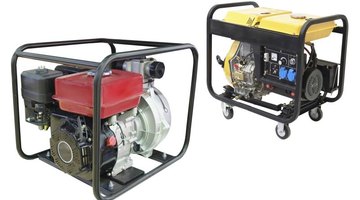What Are the Parts of a Portable Generator?
Although power outages are rare in the first world, their occurrence is not uncommon in times of severe weather conditions or other unforeseeable circumstances. Power outages can inundate your home, leaving it without heating, light, power for cooking, running computers and even medical equipment. That is, unless it is equipped with a portable generator.
Function

A portable generator is a convenient and easily transportable device that is used to provide backup electrical power to run household and other appliances. Essentially, it produces and provides its own mechanical energy with the help of a motor, which in turn converts the energy produced into electricity. That can then be used to supply much needed electrical energy to operate essential equipment.
Main Parts of a Portable Generator
A portable generator is comprised of an engine, a cooling fan, a generator, an air guide plate and a muffler, all within a closed unit. The engine and the alternating current (AC) generator, the main parts of the portable generator, are mounted on a base. A shaft is connected from the engine to the generator, driving it directly.
Generator
The generator part of the portable generator consists of a rotor, stator (a stationary coil) and two rotating magnets. The stator is comprised of wires coiled around a central metal lamination core. These coils allow the conductor to generate electrical current. One end of the generator has a fan that runs by a centrally fitted rotor bolt. This fan cools other areas of the generator.
Engine
The engine of a portable generator is equipped with several regulators. Most standardized portable generator engines turn at 3600 rpm to ensure that a standard AC current of 60 hz is produced. The engine also consists of a "governor," a device that controls the engine's speed and revolutions. The voltage regulator portion of the engine keeps the voltage at a standard 120 volts.
Circuit Breaker Switch
A portable generator also contains a circuit breaker switch, which detects excessive current flow. It protects the device receiving the power by opening a circuit between the receptacles and the generator.
References
Writer Bio
Natasha Gilani has been a writer since 2004, with work appearing in various online publications. She is also a member of the Canadian Writers Association. Gilani holds a Master of Business Administration in finance and an honors Bachelor of Science in information technology from the University of Peshawar, Pakistan.
Photo Credits
- uatp2/iStock/Getty Images
More Articles



